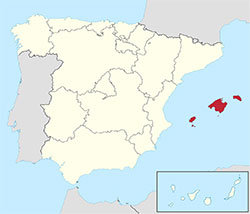Palma de Mallorca in Islas Baleares

The Balearic Islands constitute both an autonomous region and a province. The archipelago is situated in the Mediterranean Sea, off the east coast of the Iberian Peninsula. The province consists of two groups of islands and numerous islets. Mallorca, Menorca and Cabrera, with their islets constitute one group, called Islas Gimnesias, the other group, Islas Pitiusas, is made up of Ibiza and Formentera and their islets. The total land area of the Balearic Islands is 4,992 km2, and the highest point is Puig Mayor in Sierra de Tramontana in Mallorca. It reaches 1,145 MASL.
Ibiza, the island closest to the mainland is 75 km off the Spanish coast, the same distance which separates it from Mallorca. The distance between Mallorca and Menorca is 35 km. The Balearic Islands have experienced an explosion in population since the tourist boom of the 1960s. From 1975 to 2005 the number of inhabitants grew by more than 76% compared to the 29.9%, which was the average for all of Spain.
 In 2018 the population had risen to 1,128,908, and according to the town hall records, the Balearic Islands are second only to Alicante in the percentage of foreigners residing in their territory at 21.9%. More than 50% of the foreigners residing in the province come from other EU countries, mainly Germany and Great Britain.
In 2018 the population had risen to 1,128,908, and according to the town hall records, the Balearic Islands are second only to Alicante in the percentage of foreigners residing in their territory at 21.9%. More than 50% of the foreigners residing in the province come from other EU countries, mainly Germany and Great Britain.
The capital of the Balearic Islands is Palma de Mallorca, officially called just Palma. The percentage of the archipelago’s population residing in the capital is well above the average of the rest of Spain at 36.29%, compared to the national average of 31.96%.
There have been many rumours about a prehistoric settlement where modem Palma is today, but it has never been confirmed archeologically; however, it is a known fact that the Roman general Quinto Cecilio Metelo founded the city in 123 BC and called it Palmeria.
In spite of the fact that the city - and indeed all the Balearic Islands - were a favourite target for pirates and raiders, it has more or less followed in the historic footsteps of the rest of Spain with its Moorish period followed by belonging to the Crown of Aragon and finally being under the Catholic Kings.
Palma is a resort city placed on the South Western coast of Mallorca. Almost half of Mallorca’s inhabitants live here, and it has a true big city feel. More than 16 million tourists visit the city every year, a third of whom come from Germany, one third from Great Britain and the last third from the rest of the world. Palma’s cathedral, which is often called La Seu, named after the area of the city where it is situated, sits on the edge of the Bay of Palma. It is the only cathedral in the world which mirrors its image in the sea. It has Spain’s highest nave, and one of the highest in Europe.
The Paseo Maritimo, the sea front promenade, is one of the most emblematic parts of Palma. It follows the sea front from Port Pi to the airport; it is the first four kilometres that are closest to the city centre and the most visited.
It has both a pedestrian and a bicycle lane, and it is lined with palm trees throughout its length. It is one of the most visited areas of Palma, and pulses with life around the clock.
Go in the daytime to enjoy the sight of the many yachts and the old fishing port. Have tapas or a menu in one of the restaurants and bars along the Paseo, and stay until the small hours for music and dancing. Leading off from the Paseo MarItimo there is a maze of narrow streets and alleys, leading to small plazas which offer no end of boutiques, galleries and, of course, a multitude of bars and cafés.


